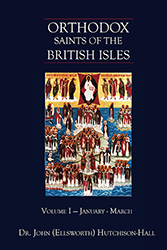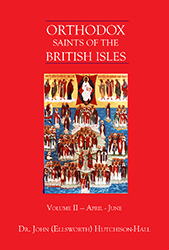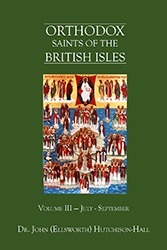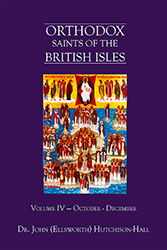
Orthodox Saints of the Pre-Schism
See of Rome
7th January 2024 (NS) — 25th December 2023 (OS)
ADALSINDIS, a nun at the double monastery Marchiennes Abbey (Abbaye Sainte-Rictrude et Saint-Pierre de Marchiennes) where her sister St. Eusebia (16th March) was Abbess. St. Adalsindis was a daughter of SS. Adalbald (2nd February) and Rictrudis (12th May), St. Adalsindis reposed circa 715.
ALBURGH (ALBURGA), a sister of King Egbert of Wessex in England, who was married to Wulstan of Wiltshire, a noble in her brother’s Court. Whilst still married St. Alburgh founded a monastery in Wilton near Salisbury, Wiltshire, England, at which she received monastic tonsure following the death of her husband in 802. St. Alburgh, lived as a monastic until her repose circa 810.
ANASTASIA of SIRMIUM, very little is known for sure about the life of St. Anastasia, the myriad of legends notwithstanding. She is believed to have been a disciple of St. Chrysogonus (24th November) and known to have been a daughter of St. Fausta of Sirmium (19th December), and was martyred by being burnt to death at Sirmium in Dalmatia circa 304, during the Diocletianic Persecution (303–313).
Troparion of St. Anastasia
Tone IV
Your lamb Anastasia, calls out to You, O Jesus, in a loud voice
I love You, my Bridegroom, and in seeking You I endure suffering.
In baptism, I was crucified so that I might reign in You, and I died so that I might live with You.
Accept me as a pure sacrifice,
for I have offered myself in love."
Through her prayers save our souls, since You are merciful.
Kontakion of St. Anastasia
Tone II
Those in temptations and afflictions hasten to your temple
And are restored by the grace that dwells in you,
For you ever pour forth healings for all the world,
O great Martyr Anastasia!
Troparion of St. Anastasia
Tone V
As a martyr, you emulated the deeds of the martyrs,
To whom you ministered,
And, striving valiantly, you overcame the enemy.
You are an abundant and overflowing source of grace
For all who come to you, O godly-minded Anastasia!
EUGENIA of ROME, a Roman noblewoman who was converted to Christianity by her servants SS. Protus and Hyacinth (11th September). She was martyred (circa 258) soon after her servants during the Valerian Persecution. St. Eugenia was later lauded in the poetry of SS. Avitus of Vienne (5th February), Aldhelm (25th May), and Venantius Fortunatus (14th December).
Troparion of Nun-Martyr
Eugenia of Rome — Tone IV
Your lamb Eugenia, O Jesus,
Calls out to You in a loud voice:
I love You, O my bridegroom,
And in seeking You, I endure suffering.
In Baptism I was crucified so that I might reign in You,
And died so that I might live with You.
Accept me as a pure sacrifice,
For I have offered myself in love.
By her prayers save our souls, since You are merciful.
Kontakion of Nun-Martyr
Eugenia of Rome — Tone IV
You left the passing glory of the world to follow Christ,
Keeping spotless the brilliance of your soul,
O inspired Martyr Eugenia, worthy of all praise!
ALDRIC (ALDERICUS, AUDRY), after spending his childhood in the court of Charlemagne, St. Aldric left at the age of twenty-one to commenced studies for the priesthood. Following ordination, he was chaplain in the court of Louis the Pious, King of the Franks (r. 814–840) for nine years. St. Aldric was consecrated fourteenth Bishop of Le Mans in 832 and was known as an excellent administrator and pastor of great personal sanctity. Following the death of Louis, St. Aldric supported Charles the Bald as successor, resulting in St. Aldric exile from Le Mans. Though he was soon reinstated by Pope Gregory IV. St. Aldric also served as Papal legate to King Pepin of Aquitaine and participated in the Council of Paris and Council of Tours. St. Aldric reposed in 856.
ANASTASIUS, fifty-fifth Archbishop of Sens in Burgundy from 967 until his repose in 976. St. Anastasius was a great champion of the Abbey of Saint-Pierre-le-Vif, in whose church his relics are enshrined.
BRANNOC of BRAUNTON, A sixth century saint, legends concerning him vary and are unreliable. However, it seems that he served for a time as tutor to the children of King St. Brychan of Brycheiniog (6th April), and accompanied the king on a pilgrimage to venerate the tombs of the Apostles, possibly stopping in Brittany on his return for several years. Returning to Britain, he founded a monastery at Braunton, near Barnstaple in Devon, where his relics are said to rest beneath the church altar.
CRISPIN (I & II), there are two St. Crispins associated with the See of Pavia in Lombardy. The first, was a third century Bishop of Pavia for 35 years, he reposed circa 250, and there is no further information on him extant. The second was Bishop of Pavia during the fifth century His episcopacy coincided with Pope St. Leo the Great’s (10th November) papacy, and St. Crispin (II) was a signatory of the acts of the Council of Milan (451) at which the bishops of northern Italy endorsed the acclaimed Epistola Dogmatica of Pope St. Leo the Great (10th November) against Nestorianism and Eutychianism. St. Crispin (II) reposed 465.
CRONAN BEG, (Seventh Century), a Bishop of Ændrum, Co. Down, Ireland, St. Cronan Beg is mentioned in connexion with the Paschal Controversy in 640. There is no further information extant.
ÉMILION (ÉMILIAN, EMILIANUS) of COMBES, a monk at Saujon near Saintes, where his wonderworking drew large numbers of pilgrims. Seeking solitude, St. Emilion fled to the forest of Combes near the present-day village of Saint-Émilion where he spent the rest of his days as a hermit. St. Emilion reposed in 767. St. Emilion is the namesake of the Bordeaux wine appellation d'origine contrôlée Saint-Émilion, and the Cour Saint-Émilion station of the Paris Metro.
KENTIGERNA (CAINTIGERN), St. Kentigerna was the daughter of Kelly, Prince of Leinster, Ireland. Upon the death of her husband, she left Ireland and moved to Inchebroida Island in Loch Lomond, Scotland, where, along with her brother St. Cóemgen (13th October) and her son St. Fáelán (Fillan) of Cluain Móescna (9th January), she lived as an anchoress until her repose 733. A church remains dedicated to her to this day.
REINOLD (RAINALD, REYNOLD), a possible descendant of Charlemagne, St. Reinhold received monastic tonsure at the Abbey of St. Pantaleon in Cologne and was given the obedience of supervising construction at the abbey. In 960 he was beaten to death by stonemasons working at the abbey and his body was thrown into a pool of water neat the Rhine River. It is said his body was later discovered through divine revelation.
TILLO (THILLO, THIELMAN, THÉAU, TILLOINE, TILLON, TILMAN), a native of Saxony who was kidnaped, enslaved, and then brought to the Low Countries. St. Eligius of Noyon (1st December) ransomed St. Tillo who then enter the Abbey of Saint-Pierre-Saint-Paul de Solignac where he received monastic tonsure and was ordained to the priesthood. St. Tillo then worked to enlighten the areas around Kortrijk and Tournai in present-day Belgium. Towards the end of his life, St. Tillo retired to live as a hermit at Solignac. He reposed 702.
VALENTINE, an abbot who became a missionary bishop in Rhaetia (roughly the area of the borders of present-day Italy, Austria, and Switzerland). Later in life St. Valentine retired to spend the rest of his days as a hermit at Mais in the Austrian Tyrol where he reposed circa 470.
WITTIKUND, a pagan Westphalian duke who converted to Christianity following a vision. With Charlemagne as his sponsor, St. Wittikund received the sacrament of Baptism in 785. He reposed circa 804 at Enger in present-day Germany.
Prior to the Schism the Patriarchate of Rome was Orthodox, and fully in communion with the Orthodox Church. As Saint John of Shanghai and San Francisco +1966 said “The West was Orthodox for a thousand years, and her venerable Liturgy is far older than any of her heresies”.
Details of British Saints excerpted from Orthodox Saints of the British Isles.
Details of continental saints from these sources.
In many cases there are several spelling versions of the names of saints from the British Isles. I use the Oxford Dictionary of National Biography version as the primary version with the more prevalent version in parenthesis e.g. Ceadda (Chad) of Lichfield.







